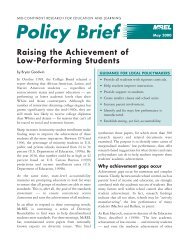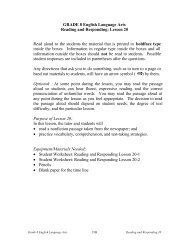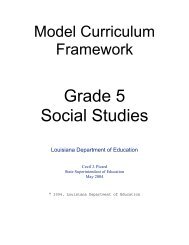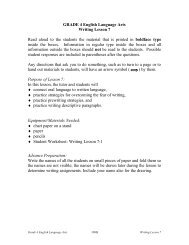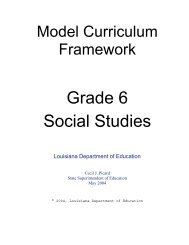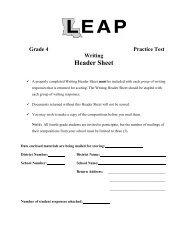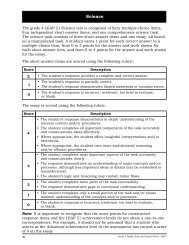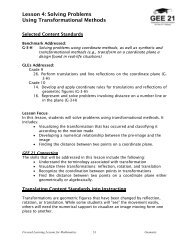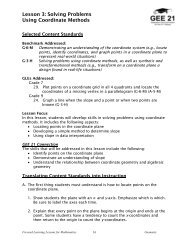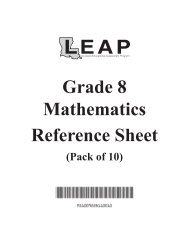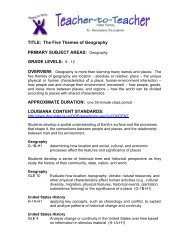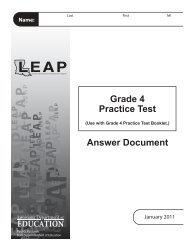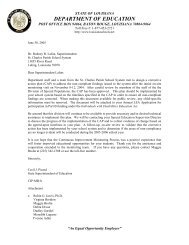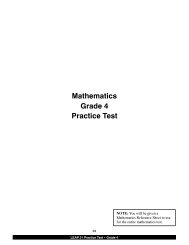Geometry EOC Assessment Guide - Louisiana Department of ...
Geometry EOC Assessment Guide - Louisiana Department of ...
Geometry EOC Assessment Guide - Louisiana Department of ...
Create successful ePaper yourself
Turn your PDF publications into a flip-book with our unique Google optimized e-Paper software.
GEOMETRY<br />
August 2012<br />
<strong>Assessment</strong> <strong>Guide</strong>
<strong>Louisiana</strong> State Board <strong>of</strong> Elementary and Secondary Education<br />
Ms. Penny Dastugue Ms. Kira Orange Jones Ms. Holly B<strong>of</strong>fy<br />
President Second BESE District Seventh BESE District<br />
Member-at-Large<br />
Ms. Lottie P. Beebe<br />
Ms. Carolyn Hill<br />
Mr. Charles E. Roemer Third BESE District Eighth BESE District<br />
Vice President<br />
Sixth BESE District Mr. Walter Lee Mr. John L. Bennett<br />
Fourth BESE District<br />
Member-at-Large<br />
Mr. James D. Garvey, Jr.<br />
Secretary/Treasurer Mr. Jay Guillot Ms. Connie Bradford<br />
First BESE District Fifth BESE District Member-at-Large<br />
Ms. Catherine Pozniak<br />
Executive Director<br />
The mission <strong>of</strong> the <strong>Louisiana</strong> <strong>Department</strong> <strong>of</strong> Education (LDOE) is to ensure equal access to education and to promote equal excellence<br />
throughout the state. The LDOE is committed to providing Equal Employment Opportunities and is committed to ensuring that all its<br />
programs and facilities are accessible to all members <strong>of</strong> the public. The LDOE does not discriminate on the basis <strong>of</strong> age, color, disability,<br />
national origin, race, religion, sex, or genetic information. Inquiries concerning the LDOE’s compliance with Title IX and other civil rights<br />
laws may be directed to the Attorney, LDOE, Office <strong>of</strong> the General Counsel, P.O. Box 94064, Baton Rouge, LA 70804-9064; 877-453-2721<br />
or customerservice@la.gov. Information about the federal civil rights laws that apply to the LDOE and other educational institutions is<br />
available on the website for the Office <strong>of</strong> Civil Rights, USDOE, at http://www.ed.gov/about/<strong>of</strong>fices/list/ocr/.<br />
This project is made possible through a grant awarded by the State Board <strong>of</strong> Elementary and Secondary Education from the <strong>Louisiana</strong> Quality<br />
Education Support Fund—8(g).<br />
This public document was published at a total cost <strong>of</strong> $6,000.00. This web-only document was published for the <strong>Louisiana</strong> <strong>Department</strong><br />
<strong>of</strong> Education, Office <strong>of</strong> Standards, <strong>Assessment</strong>s, and Accountability, Division <strong>of</strong> <strong>Assessment</strong>s and Accountability, P.O. Box 94064, Baton<br />
Rouge, LA 70804-9064, by Pacific Metrics Corporation, 1 Lower Ragsdale Drive, Building 1, Suite 150, Monterey, CA 93940. This material<br />
was published in accordance with the standards for printing by state agencies established pursuant to R.S. 43:31 and in accordance with the<br />
provisions <strong>of</strong> Title 43 <strong>of</strong> the <strong>Louisiana</strong> Revised Statutes.<br />
For further information, contact:<br />
<strong>Louisiana</strong> <strong>Department</strong> <strong>of</strong> Education’s Help Desk<br />
1-877-453-2721<br />
Ask LDOE?<br />
www.louisianaschools.net/<strong>of</strong>fices/publicaffairs/ask.aspx<br />
©2012 by <strong>Louisiana</strong> <strong>Department</strong> <strong>of</strong> Education
Table <strong>of</strong> Contents<br />
Preface<br />
What Is End-<strong>of</strong>-Course Testing? ................................................................................................ iii<br />
What Is the Purpose <strong>of</strong> the <strong>Assessment</strong> <strong>Guide</strong>? ......................................................................... iii<br />
What Does the <strong>Assessment</strong> <strong>Guide</strong> Include? ............................................................................... iii<br />
How Have the <strong>EOC</strong> <strong>Assessment</strong>s Been Affected by the Transition to the CCSS? .................... iii<br />
How Will Students and Teachers Transition to the CCSS and PARCC? ................................... iv<br />
2012–2014: Transition ......................................................................................................... iv<br />
2014–2015: Full Implementation ......................................................................................... iv<br />
When Is the <strong>Geometry</strong> <strong>EOC</strong> Test Administered? ...................................................................... iv<br />
Who Takes the <strong>Geometry</strong> <strong>EOC</strong> Test? ........................................................................................ iv<br />
How Is the <strong>Geometry</strong> <strong>EOC</strong> Test Related to the <strong>Louisiana</strong> Comprehensive Curriculum? .......... v<br />
Where May I Find Additional Information about the <strong>Geometry</strong> <strong>EOC</strong> Test? .............................. v<br />
Additional Resources .................................................................................................................. v<br />
The <strong>Geometry</strong> <strong>EOC</strong> Test<br />
Test Design .................................................................................................................................. 1<br />
Characteristics <strong>of</strong> Test Items ....................................................................................................... 1<br />
Eligible GLEs for the <strong>Geometry</strong> <strong>EOC</strong> Test ................................................................................ 1<br />
Notes Regarding GLE 9, GLE 15, and GLE 19 ......................................................................... 3<br />
Reporting Categories .................................................................................................................. 3<br />
Math Test Specifications ............................................................................................................. 4<br />
Calculator Information ................................................................................................................ 4<br />
<strong>Geometry</strong> <strong>EOC</strong> Test Tools .......................................................................................................... 4<br />
<strong>Geometry</strong> Typing Help Information ........................................................................................... 4<br />
Sample Items for the <strong>Geometry</strong> <strong>EOC</strong> Test<br />
Sample Multiple-Choice Items ................................................................................................... 5<br />
Sample Constructed-Response Item and Scoring Rubric ........................................................... 8<br />
Appendix<br />
Item Development Process ......................................................................................................... 9<br />
Test Accommodations ................................................................................................................. 9<br />
Technology Requirements ........................................................................................................ 10<br />
<strong>Geometry</strong> <strong>EOC</strong> Glossary .......................................................................................................... 10<br />
<strong>Geometry</strong> Reference Sheet ....................................................................................................... 10<br />
<strong>Geometry</strong> Typing Help .............................................................................................................. 13<br />
List <strong>of</strong> Tables<br />
Table 1: High School <strong>Assessment</strong> Implementation Plan ............................................................ iv<br />
Table 2: Suggested Testing Times ................................................................................................ 1<br />
Table 3: GLE Content to Be Taught and Tested in 2012–13 and 2013–14 .................................. 2<br />
Table 4: <strong>Geometry</strong> <strong>EOC</strong> GLEs Covered by Reporting Category ................................................ 4<br />
Table 5: <strong>Geometry</strong> <strong>EOC</strong> Coverage by Reporting Category ......................................................... 4<br />
<strong>EOC</strong> Tests <strong>Geometry</strong> <strong>Assessment</strong> <strong>Guide</strong>, August 2012<br />
i
Preface<br />
<strong>Louisiana</strong> Believes embraces the principle that all children can achieve at high levels,<br />
as evidenced in <strong>Louisiana</strong>’s recent adoption <strong>of</strong> the Common Core State Standards<br />
(CCSS). <strong>Louisiana</strong> Believes also promotes the idea that <strong>Louisiana</strong>’s educators should be<br />
empowered to make decisions to support the success <strong>of</strong> their students. In keeping with<br />
these values, the <strong>Department</strong> has created transitional assessment guides to help prepare<br />
teachers and students as they transition to the new CCSS over the next two years. These<br />
guides reflect the State’s commitment to consistent and rigorous assessments and provide<br />
educators and families with clear information about expectations for student performance.<br />
What Is End-<strong>of</strong>-Course Testing?<br />
End-<strong>of</strong>-Course (<strong>EOC</strong>) testing, a recommendation <strong>of</strong> the <strong>Louisiana</strong> High School Redesign<br />
Commission, is an increasingly common practice nationwide. <strong>EOC</strong> tests are based on<br />
state standards and help ensure consistent and rigorous instruction and expectations<br />
throughout the state. Beginning with first-time 9th graders in the 2010–2011 school year,<br />
<strong>EOC</strong> tests replaced GEE for the graduation requirements. For further information, see<br />
chapter 23 <strong>of</strong> Bulletin 741.<br />
What Is the Purpose <strong>of</strong> the <strong>Assessment</strong> <strong>Guide</strong>?<br />
The <strong>Assessment</strong> <strong>Guide</strong> provides an overview <strong>of</strong> the <strong>Geometry</strong> <strong>EOC</strong> test. In addition to<br />
providing teachers with a description <strong>of</strong> the overall design <strong>of</strong> the test, this guide presents<br />
sample test items and suggested informational resources. Teachers should use this guide to<br />
••<br />
become familiar with the <strong>Geometry</strong> <strong>EOC</strong> test format,<br />
••<br />
include similar item formats in classroom instruction and assessments,<br />
••<br />
align instruction and assessment with the <strong>Louisiana</strong> Comprehensive Curriculum and<br />
Grade-Level Expectations (GLEs), and<br />
••<br />
provide appropriate test accommodations.<br />
What Does the <strong>Assessment</strong> <strong>Guide</strong> Include?<br />
This guide includes information about<br />
••<br />
test design (format and blueprint),<br />
••<br />
test content (GLEs covered),<br />
• test scoring,<br />
• sample test items, and<br />
• test accommodations.<br />
How Have the <strong>EOC</strong> <strong>Assessment</strong>s Been Affected by the Transition to the Common<br />
Core State Standards (CCSS)?<br />
In 2010, the Board <strong>of</strong> Elementary and Secondary Education (BESE) approved the<br />
CCSS (www.doe.state.la.us/topics/common_core.html), which will eventually replace<br />
<strong>Louisiana</strong>’s English language arts (ELA) and mathematics standards and GLEs.<br />
After adopting the CCSS, <strong>Louisiana</strong> became a governing member <strong>of</strong> a 24-state consortium—<br />
the Partnership for <strong>Assessment</strong> <strong>of</strong> Readiness for College and Careers (PARCC)—working<br />
to develop next-generation assessments that measure the full range <strong>of</strong> the CCSS.<br />
<strong>EOC</strong> Tests <strong>Geometry</strong> <strong>Assessment</strong> <strong>Guide</strong>, August 2012<br />
iii
In preparation for the PARCC assessments, which are to be administered starting in the<br />
2014–2015 school year, the <strong>Department</strong> has created transitional assessments in ELA and<br />
mathematics. This revised guide provides information about the changes to the <strong>EOC</strong><br />
assessments during the transition to the CCSS.<br />
How Will Students and Teachers Transition to the CCSS and PARCC?<br />
The state has developed an implementation plan to ease the transition to the more<br />
rigorous new standards and assessments. This plan, outlined below, includes two years<br />
<strong>of</strong> implementation <strong>of</strong> transitional curriculum and assessments. Full implementation <strong>of</strong><br />
the CCSS and PARCC assessments will occur in the 2014–2015 school year. Table 1<br />
provides an overview <strong>of</strong> the assessment plan for high school.<br />
Table 1: High School <strong>Assessment</strong> Implementation Plan<br />
2012–2013 2013–2014 2014–2015<br />
Transitional Transitional PARCC<br />
2012–2014: Transition<br />
The transitional <strong>EOC</strong> assessments will be administered during the 2012–2013 and<br />
2013–2014 school years. These assessments are not designed to be more difficult than<br />
the current <strong>EOC</strong> assessments, but teachers will need to shift their instruction for their<br />
students to be fully prepared. The <strong>Geometry</strong> <strong>EOC</strong> transitional test will change to only<br />
include items that measure content common to the grade 10 GLEs and the CCSS<br />
(www.louisianaschools.net/topics/gle.html).<br />
2014–2015: Full Implementation<br />
The new PARCC assessments for the <strong>EOC</strong> courses will be administered starting in the<br />
spring <strong>of</strong> 2015. The CCSS will replace the GLEs in <strong>Geometry</strong> and Algebra I.<br />
When Is the <strong>Geometry</strong> <strong>EOC</strong> Test Administered?<br />
The <strong>Geometry</strong> <strong>EOC</strong> test is administered each May to students on traditional schedules,<br />
each December and May to students on block schedules, and in June to students who need<br />
to retest. Exact dates for administration are published in the <strong>EOC</strong> Test Administration<br />
Manual as well as on the homepage for <strong>EOC</strong> testing, www.louisianaeoc.org.<br />
Who Takes the <strong>Geometry</strong> <strong>EOC</strong> Test?<br />
The <strong>Geometry</strong> <strong>EOC</strong> test is an online assessment that is administered to all public school<br />
students upon their completion <strong>of</strong> one <strong>of</strong> the following courses, which provide content<br />
equivalent to <strong>Geometry</strong>.<br />
••<br />
<strong>Geometry</strong>—course code 160323<br />
••<br />
Applied <strong>Geometry</strong>—course code 160332<br />
<strong>EOC</strong> Tests <strong>Geometry</strong> <strong>Assessment</strong> <strong>Guide</strong>, August 2012<br />
iv
How Is the <strong>Geometry</strong> <strong>EOC</strong> Test Related to the <strong>Louisiana</strong> Comprehensive Curriculum?<br />
The <strong>Louisiana</strong> Comprehensive Curriculum was originally used as a resource to determine<br />
the appropriate content and coverage for the test. However, other curricula developed by<br />
local districts and approved by the state that address the GLEs at the appropriate level <strong>of</strong><br />
rigor will also suitably prepare students for the test. A chart <strong>of</strong> GLEs eligible for testing is<br />
shown on pages 2 and 3.<br />
Where May I Find Additional Information about the <strong>Geometry</strong> <strong>EOC</strong> Test?<br />
Information about the <strong>Geometry</strong> <strong>EOC</strong> test can be found on the <strong>EOC</strong> Tests homepage,<br />
www.louisianaeoc.org. Questions or requests for more information should be<br />
addressed to the <strong>Louisiana</strong> <strong>Department</strong> <strong>of</strong> Education (LDOE), Division <strong>of</strong> <strong>Assessment</strong>s<br />
and Accountability, by calling toll-free 877-453-2721.<br />
Additional Resources<br />
The LDOE has developed several resources to assist educators as they prepare students<br />
for the <strong>Geometry</strong> <strong>EOC</strong> test. The following materials are available on the LDOE website,<br />
www.louisianaschools.net, or on the <strong>EOC</strong> Tests homepage, www.louisianaeoc.org:<br />
••<br />
<strong>Louisiana</strong> Comprehensive Curriculum<br />
www.doe.state.la.us/topics/comprehensive_curriculum.html<br />
••<br />
<strong>EOC</strong> online demonstration site and tutorials<br />
www.louisianaeoc.org (demo site under Login drop-down menu; tutorials under<br />
Technology Resources drop-down menu)<br />
••<br />
PASS (Practice <strong>Assessment</strong>/Strengthen Skills)<br />
www.louisianapass.org<br />
••<br />
Released test items from other <strong>Louisiana</strong> assessments that cover similar content<br />
www.louisianaeoc.org/released_test_items.php<br />
••<br />
<strong>Assessment</strong> guides from other <strong>Louisiana</strong> assessments that cover similar content<br />
www.louisianaeoc.org/Documents/Algebra_<strong>Assessment</strong>_<strong>Guide</strong>.pdf<br />
••<br />
Focused Learning Lessons<br />
www.doe.state.la.us/topics/focused_learning_lessons.html<br />
••<br />
Enhanced <strong>Assessment</strong> <strong>of</strong> Grade-Level Expectations (EAGLE)—Grade 10 Mathematics<br />
www.louisianaeagle.org/pma/orca2/diag.htm<br />
••<br />
<strong>EOC</strong> Tests: Frequently Asked Questions (FAQs)<br />
www.louisianaeoc.org (under Welcome drop-down menu)<br />
<strong>EOC</strong> Tests <strong>Geometry</strong> <strong>Assessment</strong> <strong>Guide</strong>, August 2012<br />
v
The <strong>Geometry</strong> <strong>EOC</strong> Test<br />
Test Design<br />
The <strong>Geometry</strong> <strong>EOC</strong> test includes three sessions:<br />
••<br />
25-item multiple-choice session that does not allow the use <strong>of</strong> calculators<br />
••<br />
3-item constructed-response session that allows the use <strong>of</strong> calculators<br />
••<br />
25-item multiple-choice session that allows the use <strong>of</strong> calculators<br />
Forty-six multiple-choice and two constructed-response items are operational. The remaining<br />
five items are embedded field test items, which are used to develop new forms.<br />
The suggested testing times for the <strong>Geometry</strong> test listed in Table 2 are only estimates. There<br />
are no strict time limits for the <strong>EOC</strong> tests.<br />
Table 2: Suggested Testing Times<br />
Session Description Number <strong>of</strong> Items Testing Time<br />
1 Multiple Choice, No Calculator 25 60 minutes<br />
2 Constructed Response, Calculator 3 30 minutes<br />
3 Multiple Choice, Calculator 25 60 minutes<br />
TOTAL 53 150 minutes<br />
Information about additional time needed to read test directions to students, assist students<br />
with the log-in process, and accomplish other activities related to test administration is<br />
included in the <strong>EOC</strong> Test Administration Manual.<br />
Characteristics <strong>of</strong> Test Items<br />
Multiple-choice items assess knowledge, conceptual understanding, and application <strong>of</strong> skills.<br />
The items consist <strong>of</strong> an interrogatory stem followed by four response options (A, B, C, D)<br />
and are scored as correct or incorrect.<br />
Constructed-response items require students to compose an answer; these items generally<br />
require higher-order thinking. A typical constructed-response item may require students<br />
to develop an idea, demonstrate a problem-solving strategy, or justify an answer based on<br />
reasoning or evidence. The <strong>Geometry</strong> <strong>EOC</strong> test constructed-response items are scored<br />
on a 0–2 point scale.<br />
Eligible GLEs for the <strong>Geometry</strong> <strong>EOC</strong> Test<br />
As <strong>Louisiana</strong> students and teachers transition to the Common Core State Standards (CCSS)<br />
and Partnership for <strong>Assessment</strong> <strong>of</strong> Readiness for College and Careers (PARCC) assessments,<br />
the math tests will include only items measuring GLEs aligned to the CCSS. Table 3<br />
provides a list <strong>of</strong> GLEs eligible for assessment during the transition. The table identifies<br />
the GLEs and the corresponding CCSS alignment.<br />
<strong>EOC</strong> Tests <strong>Geometry</strong> <strong>Assessment</strong> <strong>Guide</strong>, August 2012<br />
1
GLE<br />
Table 3: GLE Content to Be Taught and Tested in 2012–13 and 2013–14<br />
Text <strong>of</strong> GLE<br />
3 Define sine, cosine, and tangent in ratio form and calculate them<br />
using technology<br />
4 Use ratios and proportional reasoning to solve a variety <strong>of</strong> real-life<br />
problems, including similar figures and scale drawings<br />
5 Write the equation <strong>of</strong> a line <strong>of</strong> best fit for a set <strong>of</strong> 2-variable real-life<br />
data presented in table or scatter plot form, with or without technology<br />
6 Write the equation <strong>of</strong> a line parallel or perpendicular to a given line<br />
through a specific point<br />
Aligned<br />
CCSS<br />
G-SRT.6<br />
G-SRT.5<br />
S-ID.6<br />
G-GPE.5<br />
7 Find volume and surface area <strong>of</strong> pyramids, spheres, and cones G-GMD.3<br />
8 Model and use trigonometric ratios to solve problems involving right<br />
triangles<br />
9 Construct 2- and 3-dimensional figures when given the name,<br />
description, or attributes, with and without technology<br />
G-SRT.8<br />
G-CO.12<br />
G-CO.13<br />
G-C.3<br />
G-C.4<br />
12 Apply the Pythagorean theorem in both abstract and real-life settings G-SRT.8<br />
13 Solve problems and determine measurements involving chords, radii,<br />
arcs, angles, secants, and tangents <strong>of</strong> a circle<br />
14 Develop and apply coordinate rules for translations and reflections <strong>of</strong><br />
geometric figures<br />
15 Draw or use other methods, including technology, to illustrate<br />
dilations <strong>of</strong> geometric figures<br />
16 Represent and solve problems involving distance on a number line or<br />
in the plane<br />
18 Determine angle measures and side lengths <strong>of</strong> right and similar<br />
triangles using trigonometric ratios and properties <strong>of</strong> similarity,<br />
including congruence<br />
19 Develop formal and informal pro<strong>of</strong>s (e.g., Pythagorean theorem,<br />
flow charts, paragraphs)<br />
G-C.2<br />
G-CO.2<br />
G-CO.5<br />
G-CO.2<br />
G-CO.5<br />
G-GPE.6<br />
G-GPE.7<br />
G-SRT.5<br />
G-SRT.8<br />
G-CO.9<br />
G-CO.10<br />
G-CO.11<br />
G-SRT.4<br />
G-C.1<br />
G-GPE.4<br />
G-GPE.5<br />
G-GMD.1<br />
G-GMD.2<br />
G-SRT.5<br />
G-SRT.10<br />
G-C.3<br />
<strong>EOC</strong> Tests <strong>Geometry</strong> <strong>Assessment</strong> <strong>Guide</strong>, August 2012<br />
2
GLE<br />
Text <strong>of</strong> GLE<br />
20 Show or justify the correlation (match) between a linear or nonlinear<br />
data set and a graph<br />
21 Determine the probability <strong>of</strong> conditional and multiple events,<br />
including mutually and non-mutually exclusive events<br />
22 Interpret and summarize a set <strong>of</strong> experimental data presented in a<br />
table, bar graph, line graph, scatter plot, matrix, or circle graph<br />
25 Use discrete math to model real-life situations (e.g., fair games,<br />
elections)<br />
26 Generalize and represent patterns symbolically, with and without<br />
technology<br />
Aligned<br />
CCSS<br />
S-ID.6<br />
S-CP.6<br />
S-CP.7<br />
S-CP.8<br />
S-CP.4<br />
S-CP.3<br />
S-ID.5<br />
S-CP.4<br />
S-MD.6<br />
S-MD.7<br />
S-IC.2<br />
F-IF.3<br />
Notes Regarding GLE 9, GLE 15, and GLE 19<br />
The following information clarifies the main ways that GLE 9, GLE 15, and GLE 19 will<br />
be assessed on the <strong>Geometry</strong> <strong>EOC</strong> test.<br />
••<br />
For most items measuring GLE 9, students will be given the name, description, or<br />
attributes <strong>of</strong> a figure. Students will be asked to select the figure (name or picture)<br />
determined by this information. Students will not construct figures.<br />
••<br />
For most items measuring GLE 15, students will be given a figure and a description<br />
<strong>of</strong> a dilation. Students will be asked to predict the effects <strong>of</strong> the dilation. Alternatively,<br />
students will be given a dilated figure and asked to describe the dilation that produced<br />
the figure. Students will not draw figures.<br />
••<br />
For most multiple-choice items measuring GLE 19, students will be asked to justify<br />
simple claims, identify a missing step (statement and/or reason) in a pro<strong>of</strong>, or select<br />
the theorem (e.g., side-angle-side congruence) that establishes a particular result.<br />
Students will not devise full-length pro<strong>of</strong>s (informal or formal) on multiple-choice<br />
items. Students may, however, be expected to provide complete geometric pro<strong>of</strong>s on<br />
the constructed-response items.<br />
Reporting Categories<br />
In order to better reflect the focus areas <strong>of</strong> the CCSS at each grade, the GLEs available<br />
for assessment have been grouped into the Reporting Categories shown in Table 4.<br />
During the transition, the Reporting Categories replace the mathematics strands<br />
(e.g., Number and Number Relations, Algebra, etc.) for assessment purposes.<br />
<strong>EOC</strong> Tests <strong>Geometry</strong> <strong>Assessment</strong> <strong>Guide</strong>, August 2012<br />
3
Table 4: <strong>Geometry</strong> <strong>EOC</strong> GLEs by Reporting Category<br />
Reporting Category<br />
GLEs Covered<br />
<strong>Geometry</strong> 9, 12, 13, 14, 15, 16, 18, 19<br />
Proportion and Algebra 3, 4, 5, 6, 8, 26<br />
Measurement and Data 7, 20, 21, 22, 25<br />
Math Test Specifications<br />
Table 5 provides test specifications for the <strong>Geometry</strong> <strong>EOC</strong> test.<br />
Table 5: <strong>Geometry</strong> <strong>EOC</strong> Coverage by Reporting Category<br />
Reporting Category<br />
Approximate Percentage<br />
<strong>Geometry</strong> 60%<br />
Proportion and Algebra 24%<br />
Measurement and Data 16%<br />
TOTAL 100%<br />
Calculator Information<br />
The <strong>Geometry</strong> <strong>EOC</strong> test includes three sessions, two <strong>of</strong> which allow the use <strong>of</strong> calculators.<br />
In the sessions that allow calculator use, students may use the hand-held calculators<br />
(graphing or scientific) normally used during instruction. Students may not use calculators<br />
with Computer Algebra Systems (CAS) or other symbolic manipulation capabilities.<br />
An online scientific calculator is also provided. Students may practice using this online<br />
calculator by going to the <strong>EOC</strong> Tests homepage (www.louisianaeoc.org) and selecting<br />
Test Coordinator Materials, Testing Materials, and <strong>EOC</strong> Tests Online Calculator.<br />
<strong>Geometry</strong> <strong>EOC</strong> Test Tools<br />
An online inch ruler, a centimeter ruler, and a protractor are available to students for<br />
specific items during the <strong>EOC</strong> <strong>Geometry</strong> test. Students may practice using similar tools<br />
by visiting <strong>Louisiana</strong> PASS at www.louisianapass.org and taking mathematics practice<br />
tests at the High School level, or by going to the <strong>EOC</strong> Online Demonstration Site at<br />
https://eocdemo.louisianaeoc.org/.<br />
A reference sheet pop-up window is available for the <strong>Geometry</strong> <strong>EOC</strong> test. A copy <strong>of</strong> the<br />
<strong>Geometry</strong> Reference Sheet, which may be provided to students in hard copy, is included<br />
in the appendix <strong>of</strong> this guide. Graph paper and scratch paper are also provided to students<br />
during testing.<br />
<strong>Geometry</strong> Typing Help Information<br />
To assist students in typing mathematical symbols and other elements in the constructed<br />
responses in Session 2, the <strong>Geometry</strong> <strong>EOC</strong> test includes a Typing Help pop-up window.<br />
See the appendix for hard copy, which may be provided to students.<br />
<strong>EOC</strong> Tests <strong>Geometry</strong> <strong>Assessment</strong> <strong>Guide</strong>, August 2012<br />
4
Sample Items for the <strong>Geometry</strong> <strong>EOC</strong> Test<br />
Sample Multiple-Choice Items<br />
Four sample multiple-choice items follow. The content and format <strong>of</strong> these items are<br />
similar to actual items that will be included on the <strong>Geometry</strong> <strong>EOC</strong> test. Correct responses<br />
are indicated by an asterisk (*).<br />
GLE 5—Write the equation <strong>of</strong> a line <strong>of</strong> best fit for a set <strong>of</strong> 2-variable real-life data<br />
presented in table or scatter plot form, with or without technology.<br />
Use the scatter plot to answer the question.<br />
Circular Objects<br />
50<br />
48<br />
46<br />
Circumference (cm)<br />
44<br />
42<br />
40<br />
38<br />
36<br />
34<br />
32<br />
30<br />
0<br />
6 8 10 12<br />
Radius (cm)<br />
Students in Mark’s class measured the radii and circumferences <strong>of</strong><br />
several different objects. The graph shows the relationship between the<br />
radius and the circumference <strong>of</strong> each object. Which number is closest<br />
to the slope <strong>of</strong> the line <strong>of</strong> best fit for this graph?<br />
A 1<br />
B 2<br />
* C 6<br />
D 9<br />
<strong>EOC</strong> Tests <strong>Geometry</strong> <strong>Assessment</strong> <strong>Guide</strong>, August 2012<br />
5
GLE 7—Find volume and surface area <strong>of</strong> pyramids, spheres, and cones.<br />
The radius <strong>of</strong> a spherical soccer ball is 5 inches. Which measurement<br />
is closest to the volume <strong>of</strong> the soccer ball?<br />
A<br />
B<br />
* C<br />
D<br />
125 cubic inches<br />
393 cubic inches<br />
524 cubic inches<br />
1,571 cubic inches<br />
GLE 9—Construct 2- and 3-dimensional figures when given the name, description,<br />
or attributes, with and without technology.<br />
A traffic sign is in the shape <strong>of</strong> a quadrilateral. It has four congruent<br />
sides and no right angles. Which statement must be true?<br />
A<br />
* B<br />
C<br />
D<br />
The sign is a square.<br />
The sign is a rhombus.<br />
The sign is a rectangle.<br />
The sign is a trapezoid.<br />
<strong>EOC</strong> Tests <strong>Geometry</strong> <strong>Assessment</strong> <strong>Guide</strong>, August 2012<br />
6
GLE 12—Apply the Pythagorean theorem in both abstract and real-life settings.<br />
Use the right triangle to answer the question.<br />
4 cm<br />
8 cm<br />
A jewelry designer places wire around a glass tile that is shaped like<br />
a right triangle. The base <strong>of</strong> the tile is 8 centimeters and the height is<br />
4 centimeters.<br />
To the nearest hundredth <strong>of</strong> a centimeter, how much wire is needed?<br />
A<br />
B<br />
C<br />
15.46 cm<br />
16.90 cm<br />
18.93 cm<br />
*D 20.94 cm<br />
<strong>EOC</strong> Tests <strong>Geometry</strong> <strong>Assessment</strong> <strong>Guide</strong>, August 2012<br />
7
Sample Constructed-Response Item and Scoring Rubric<br />
A sample constructed-response (CR) item follows, along with its scoring rubric.<br />
A maximum score <strong>of</strong> 2 is possible for CR items on the <strong>Geometry</strong> <strong>EOC</strong> test. The content<br />
and format <strong>of</strong> this item are similar to actual CR items that will be included on the<br />
<strong>Geometry</strong> <strong>EOC</strong> test.<br />
GLE 19—Develop formal and informal pro<strong>of</strong>s (e.g., Pythagorean theorem, flow<br />
charts, paragraphs).<br />
Mr. Young challenged his class to draw a quadrilateral with exactly<br />
3 right angles. Explain why such a shape is impossible to draw.<br />
Sample Exemplary Response<br />
The shape is impossible. In a quadrilateral, the sum <strong>of</strong> the four angle<br />
measures is always 360 degrees. If three <strong>of</strong> the angles are right angles,<br />
then these three right angles add up to 270 degrees. The fourth angle<br />
would also have to be 90 degrees because 360 − 270 = 90. This means<br />
there can’t be exactly 3 right angles.<br />
Points Assigned<br />
●●<br />
●●<br />
●●<br />
1 point for a response that refers to the sum <strong>of</strong> angle measures<br />
as 360 degrees<br />
1 point for a response that identifies the fourth angle as 90 degrees<br />
1 point for a clear and logical flow throughout response<br />
Scoring Rubric<br />
Score<br />
Description<br />
2 3 points<br />
1 1 or 2 points or the student’s response demonstrates<br />
minimal understanding <strong>of</strong> how to develop formal and<br />
informal pro<strong>of</strong>s<br />
0 The student’s response is incorrect, irrelevant, too brief<br />
to evaluate, or blank.<br />
<strong>EOC</strong> Tests <strong>Geometry</strong> <strong>Assessment</strong> <strong>Guide</strong>, August 2012<br />
8
Appendix<br />
Item Development Process<br />
Test items for the <strong>Geometry</strong> <strong>EOC</strong> test are developed by pr<strong>of</strong>essional test developers<br />
under contract with the state.<br />
Items are reviewed and approved by <strong>Louisiana</strong> educators through state-level item<br />
review workshops. All <strong>EOC</strong> test items are developed to align with the GLEs for grade<br />
10 mathematics.<br />
Test Accommodations<br />
Accommodations are available to qualifying students who are classified as IDEA Special<br />
Education, Section 504, and Limited English Pr<strong>of</strong>icient (LEP). Test accommodations<br />
should not be different from or in addition to the accommodations provided in<br />
the classroom during instruction and as indicated on the student’s Individualized<br />
Education Program (IEP), Section 504 Individual Accommodation Plan (IAP), or LEP<br />
accommodation plan. Testing and instructional accommodations must be based on each<br />
student’s needs as documented in the student’s IEP, IAP, or LEP plan.<br />
For students with disabilities, test accommodations are provided to minimize the effects<br />
<strong>of</strong> a disability to ensure that a student can demonstrate the degree <strong>of</strong> achievement he<br />
or she actually possesses. An accommodation is a change in the setting <strong>of</strong> the test<br />
administration, the timing, scheduling, presentation format, and/or method <strong>of</strong> response<br />
to the assessment. Not all students with disabilities will need test accommodations, but<br />
many will need them to provide a valid and accurate measure <strong>of</strong> their abilities. The goal<br />
in using accommodations is to give students with disabilities an equal opportunity in<br />
assessment, not to give students with disabilities an unfair advantage over other students<br />
or to subvert or invalidate the purpose <strong>of</strong> the tests. The accommodation should allow the<br />
test score to reflect a student’s pr<strong>of</strong>iciency in the area tested, without the interference <strong>of</strong><br />
his or her disability.<br />
Students classified as Limited English Pr<strong>of</strong>icient (LEP) may receive LEP accommodations<br />
if they are used regularly in the student’s classroom instruction and assessment.<br />
LEP accommodations are provided for these students to aid them in accessing the content.<br />
Special online test forms are available to students who are assigned Large Print or<br />
Tests Read Aloud accommodations. Braille test forms also are available. Other allowed<br />
accommodations for students with IEPs or Section 504 IAPs are Assistive Technology,<br />
Communication Assistance, Individual/Small Group Administration, and Extended<br />
Time. Use <strong>of</strong> the following LEP accommodations will be determined by the classroom<br />
teacher and ESL teacher or other individual providing language services: Extended<br />
Time, Individual/Small Group Administration, Provision <strong>of</strong> English/Native Language<br />
Word-to-Word Dictionary (No Definitions), Test Administered by ESL Teacher or by<br />
Individual Providing Language Services, and Tests Read Aloud.<br />
<strong>EOC</strong> Tests <strong>Geometry</strong> <strong>Assessment</strong> <strong>Guide</strong>, August 2012<br />
9
Since accommodations used during state assessments must be an ongoing part <strong>of</strong> classroom<br />
instruction and assessment, it is crucial that general educators be knowledgeable about<br />
accommodations, use them routinely in the classroom, and be prepared to implement the<br />
use <strong>of</strong> approved accommodations during state assessments.<br />
For a list <strong>of</strong> approved test accommodations that may be used for students with disabilities<br />
or LEP students and suggestions for implementing accommodations during assessment,<br />
refer to the <strong>EOC</strong> Test Administration Manual, which will be available approximately two<br />
weeks prior to testing and the <strong>Guide</strong>lines for Test Accommodations posted on the LDOE<br />
website, www.louisianaschools.net.<br />
Technology Requirements<br />
The <strong>Geometry</strong> test is administered online only, with the exception <strong>of</strong> the braille test;<br />
therefore, schools will need to ensure that appropriate technology requirements are<br />
met. The <strong>EOC</strong> Test Administration Manual provides general information on how to<br />
prepare for online testing. For more specific technology information, refer to the<br />
<strong>EOC</strong> Tests Technology <strong>Guide</strong>lines, which are posted on the <strong>EOC</strong> Tests homepage.<br />
<strong>Geometry</strong> <strong>EOC</strong> Glossary<br />
This brief glossary includes definitions <strong>of</strong> specialized vocabulary associated with the<br />
<strong>EOC</strong> assessments.<br />
••<br />
accommodation: a change in the setting <strong>of</strong> the test administration, the timing, scheduling,<br />
presentation format, and/or method <strong>of</strong> response to the assessment<br />
••<br />
assessment: a test designed to measure knowledge, skills, or abilities<br />
••<br />
constructed-response (CR) item: any open-ended item in which students write their own<br />
responses<br />
••<br />
graphing calculator: a calculator that includes the capability to graph functions<br />
••<br />
item: a question or prompt that is designed to measure particular knowledge, skills, or abilities<br />
••<br />
multiple-choice (MC) item: an item in which students select a correct answer from among<br />
more than one response option<br />
••<br />
response option: one <strong>of</strong> the answer choices that comprise a multiple-choice test item<br />
••<br />
rubric: a set <strong>of</strong> rules or criteria for scoring student responses to constructed-response items<br />
••<br />
scientific calculator: a calculator that includes advanced functions such as square root and<br />
trigonometric functions but does not include the capability to graph functions<br />
(see graphing calculator)<br />
<strong>Geometry</strong> Reference Sheet<br />
For all items on the <strong>Geometry</strong> <strong>EOC</strong> test, students may access the <strong>Geometry</strong> Reference<br />
Sheet pop-up window, shown on pages 11 and 12.<br />
<strong>EOC</strong> Tests <strong>Geometry</strong> <strong>Assessment</strong> <strong>Guide</strong>, August 2012<br />
10
<strong>Geometry</strong> Reference Sheet<br />
Use the information below to answer<br />
questions on the <strong>Geometry</strong> test.<br />
Pythagorean Theorem<br />
a<br />
c<br />
a 2 + b 2 = c 2<br />
b<br />
Sphere<br />
r<br />
π ≈ 314 .<br />
Surface Area = 4πr<br />
2<br />
Volume = 4 πr<br />
3<br />
3<br />
Cone<br />
Surface Area πrs πr 2<br />
h s 1<br />
Volume = π r 2 h<br />
r<br />
3<br />
Cylinder<br />
r<br />
2<br />
Surface Area = 2πr<br />
+ 2πrh<br />
h Volume = πr 2 h<br />
Regular Pyramid<br />
s<br />
h<br />
b<br />
B = area <strong>of</strong> base<br />
L = area <strong>of</strong> lateral surfaces<br />
Surface Area = B+<br />
L<br />
Volume =<br />
1<br />
Bh<br />
3<br />
<strong>EOC</strong> Tests <strong>Geometry</strong> <strong>Assessment</strong> <strong>Guide</strong>, August 2012<br />
11
Rectangular Solid<br />
l<br />
w<br />
h<br />
Surface Area = 2wl + 2lh + 2wh<br />
Volume = lwh<br />
Circle<br />
r<br />
2<br />
Area = πr<br />
Circumference = 2πr<br />
Rectangle<br />
l<br />
w<br />
Area = lw<br />
Perimeter = 2l<br />
2w<br />
Trapezoid<br />
h<br />
b 1<br />
Area = 1 2 h<br />
( b 1<br />
+ b 2<br />
)<br />
b 2<br />
Triangle<br />
h<br />
Area = 1 2 bh<br />
b<br />
Parallelogram<br />
h<br />
Area = bh<br />
b<br />
Cartesian Distance<br />
Formula<br />
Point 1:<br />
( x 1<br />
, y 1<br />
)<br />
Point 2: ( x 2<br />
, y 2<br />
)<br />
d =<br />
( x 2<br />
– x 1<br />
) 2 + ( y 2<br />
– y 1<br />
) 2<br />
<strong>EOC</strong> Tests <strong>Geometry</strong> <strong>Assessment</strong> <strong>Guide</strong>, August 2012<br />
12
<strong>Geometry</strong> Typing Help<br />
For Session 2, the constructed-response portion <strong>of</strong> the <strong>Geometry</strong> <strong>EOC</strong> test, students may<br />
need to use the following keystrokes to enter special symbols within their responses.<br />
1. If the Response<br />
Includes:<br />
×<br />
multiplication symbol<br />
÷<br />
division symbol<br />
2. Type This Instead: 3. Example:<br />
x<br />
letter x<br />
OR<br />
*<br />
asterisk (SHIFT + 8)<br />
/<br />
forward slash<br />
3 x 4 = 12<br />
3 * 4 = 12<br />
12 / 3 = 4<br />
fraction or ratio<br />
2 3 4<br />
mixed number<br />
3 2<br />
exponent<br />
pi symbol<br />
≥<br />
“greater than or equal to”<br />
≤<br />
“less than or equal to”<br />
square root<br />
about equal to<br />
45º<br />
degree symbol<br />
/<br />
forward slash<br />
space between whole<br />
number and fraction;<br />
forward slash to separate<br />
numerator and<br />
denominator <strong>of</strong> fraction<br />
^<br />
“caret” (SHIFT + 6)<br />
(pi)<br />
>=<br />
greater than sign, followed<br />
by equals sign<br />
= 13<br />
y
<strong>Geometry</strong> Typing Help (continued)<br />
angle symbol<br />
∆ ABC<br />
triangle symbol<br />
m q<br />
perpendicular symbol<br />
m || q<br />
parallel symbol<br />
∆ ABC ∆ RST<br />
congruence symbol<br />
∆STU ~ ∆VWX<br />
similarity symbol<br />
angle<br />
(spell out the word)<br />
triangle<br />
(spell out the word)<br />
perpendicular<br />
(spell out the word)<br />
||<br />
two “pipes” (SHIFT +<br />
backslash)<br />
OR<br />
parallel<br />
(spell out the word)<br />
congruent<br />
(spell out the word)<br />
similar<br />
(spell out the word)<br />
Angle PQR is a right angle.<br />
Triangle ABC is a right<br />
triangle.<br />
Line m is perpendicular to<br />
line q.<br />
m || q<br />
OR<br />
Line m is parallel to line q.<br />
Triangle ABC is congruent<br />
to triangle RST.<br />
Triangle STU is similar to<br />
triangle VWX.<br />
line segment<br />
line<br />
ray<br />
line segment<br />
(spell out the words)<br />
line<br />
(spell out the word)<br />
ray<br />
(spell out the word)<br />
Line segment AB bisects<br />
line segment CD.<br />
Line AB is parallel to<br />
line CD.<br />
Ray AB goes through<br />
point P.<br />
<strong>EOC</strong> Tests <strong>Geometry</strong> <strong>Assessment</strong> <strong>Guide</strong>, August 2012<br />
14
END-OF-COURSE<br />
TESTS<br />
August 2012<br />
<strong>Louisiana</strong> <strong>Department</strong> <strong>of</strong> Education<br />
Office <strong>of</strong> Standards, <strong>Assessment</strong>s, and Accountability<br />
Division <strong>of</strong> <strong>Assessment</strong>s and Accountability



